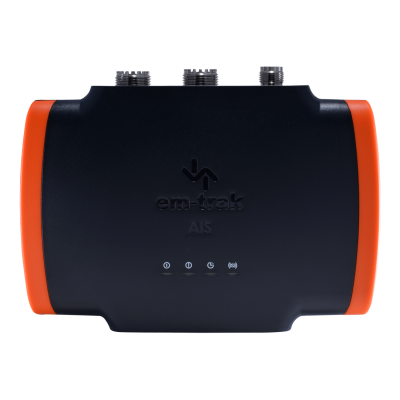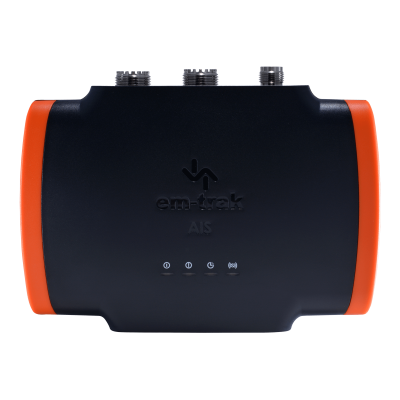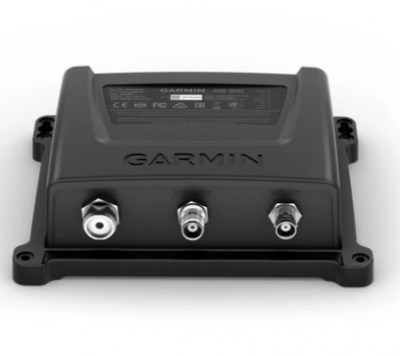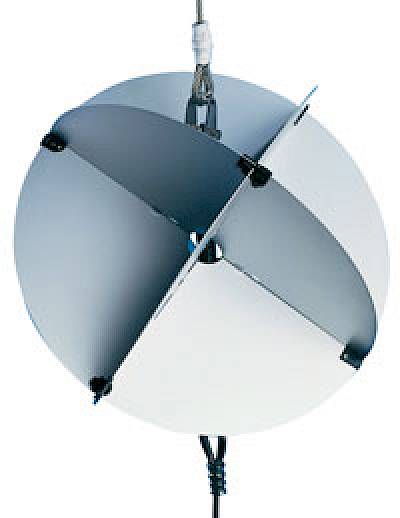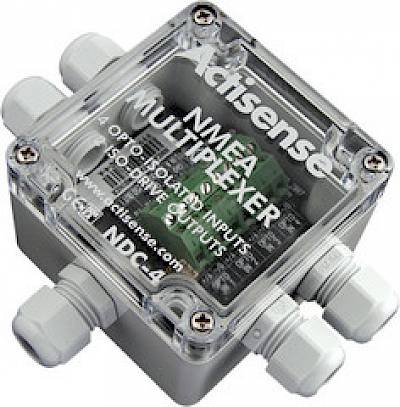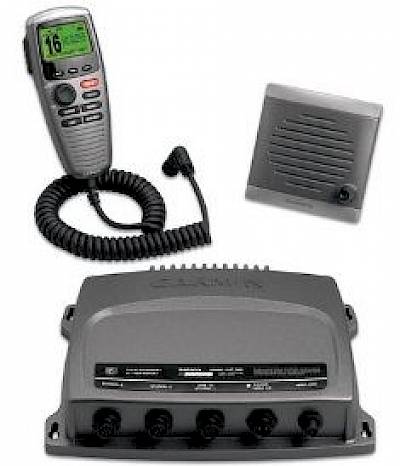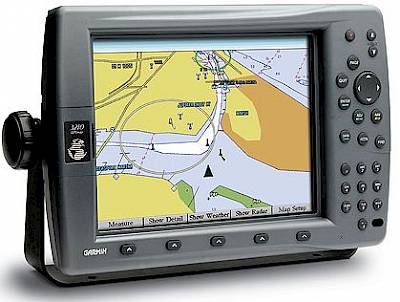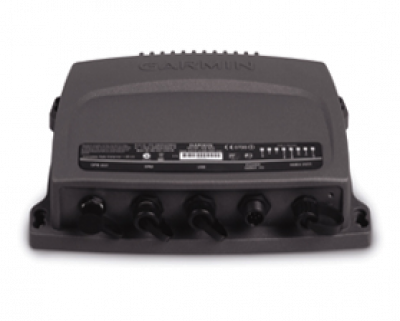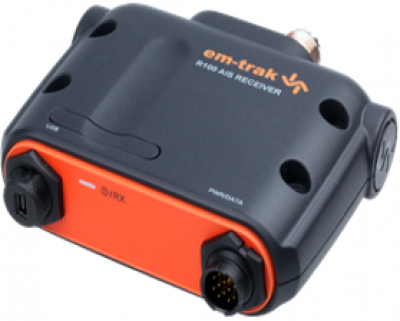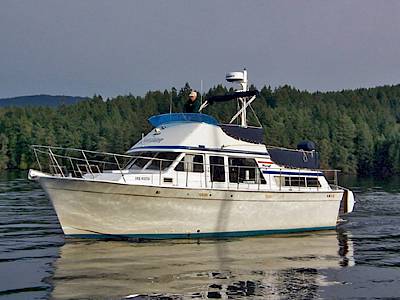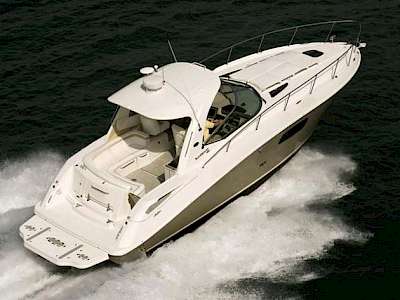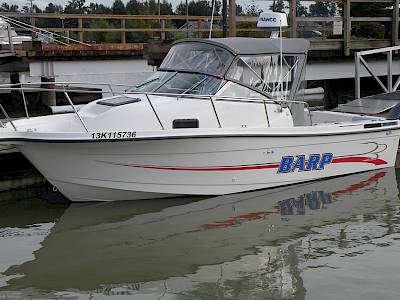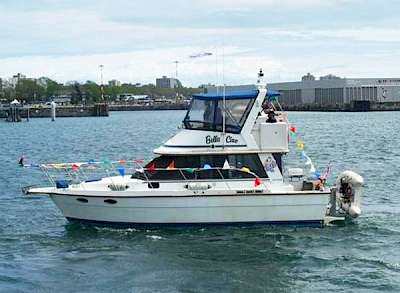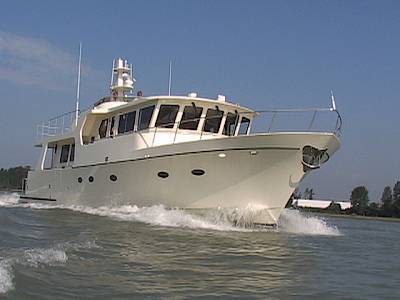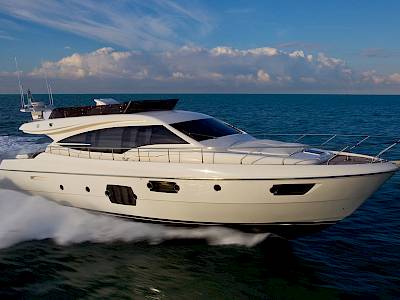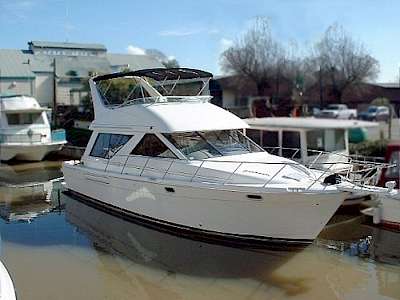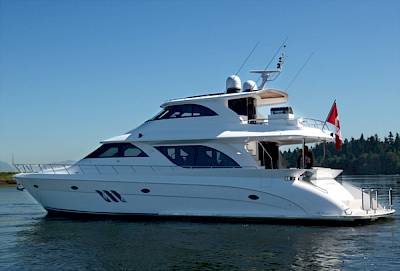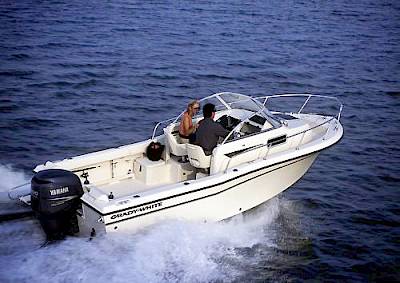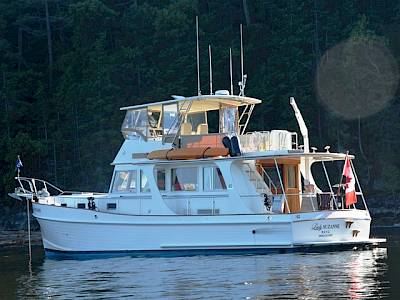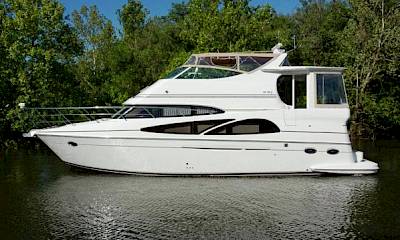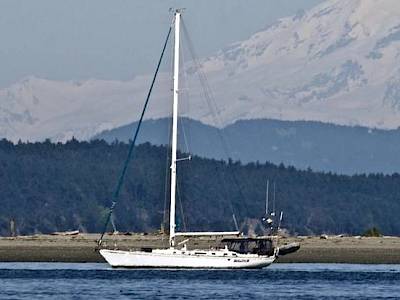Boat Show 2018 - AIS Makes Boating Safer
Transcript is auto-generated.
we're gonna get started on today's we're going to talk about a is so what does the first thing is to ask ourselves is what does a is stands for automatic identification system just a little bit for context everyone in the room some of you might know us some of you might not I'm Jeff Cote with Pacific yacht systems and I'm an owner operator of a marine electrical electronic company here in Vancouver and also Sunshine Coast and now Vancouver Island and our main focus is strictly electrical and electronics for marine so we have about a dozen of us on the team and today what I'm doing is I'm sharing our collective experience of working on all your fellow boaters boats so last year we did about 750 boats that we worked on and what I'm trying to share with everyone or what are the benefits and why are some other boaters or fellow boaters taking on a is on their boat and why are they doing it and what are the benefits and what are some of the products you can consider for your own boat alright so first thing I mean the big takeaways from the presentation are gonna be for me is you know at the end of the presentation you should ask yourself how does a is improve myself vessel safety so that should be one of the points that we want to cover in this presentation the next one is you know what about the location of NAIS antenna do I need one do I use a VHF antenna do I buy a splitter we're going to talk about that also talk about if you can use a VHF antenna for a is [Music] maybe talk a little bit about EMI but we're gonna dabble into that a little bit first things what's the purpose and why are people talking about is for for boats I mean ultimately the real purpose if you want to say in a nutshell is to really it's for safety it's about positional awareness of your boat and other people's boat that can be seen on a display we'll talk about the different sort of displays but it's really about sharing information of where your boat is its current location and where it's going between all boats so everyone's aware of where one is the water so it's vessel the vessel vessel to shore and it's a period it's it's a broadcast of information but not a continuous stream of information meaning depending on the type of transponder you have on your boat there's different frequencies so you might be updating every three minutes six minutes it's not constantly saying Here I am I'm here I'm here I'm here right so this information is there but it's not unlike your site your site is constantly giving you feedback where someone is you know the speed of light travels instantly for what we notice and so you're always being updated on where someone is but with a is is giving you a sample otherwise your the the VHF frequencies would be too cluttered so it's telling you where a vote is every three minutes and eventually with that information you can figure where the vote is gonna be but it's not going to tell you where it was every second because otherwise there's just be simply too much voting information on the app so one example of that is someone who turns on their ais receiver and instantly looks an app on their phone and wonder why they're a is vessel is not on the on the app well it's not the moment you turn it on it takes a while before we broadcast a ship station or Shore station is gonna pick it up send it to the Internet you're gonna connect to the internet on your app and then you're gonna see this vessel so you got to give it a little bit of time it's not real time radar would be the opposite radars in real time when the one sweep happens it tells you every time where that boat is every suite so what are you gonna see with AIS you're gonna see surrounding traffic you're gonna see local commercial traffic so you're in British Columbia the things that you're gonna see are gonna be all the freighters most tugboats are gonna be using it a lot of trawlers fishing trawlers are going to be using it and you're gonna be seeing a lot of information like what's the boat name where's the boat some of them even take the time to actually enter where they're going what's their speed on ground what's the length of the boat the width of the boat the speed of the boat all that information is sent over VHF frequencies within a subset of VHF and we'll talk about that a little bit later and that information is appearing on your boat there's different ways of harnessing or getting that information and we'll talk about that a little bit later but you're getting all that over the air so what that means is you could literally be in the middle of the Pacific Ocean the farthest point from land on earth have no internet connectivity though everything has fallen there is nothing left on earth and two ships will be able to communicate directly via VHF frequencies so it's not dependent on going back to land to come back to your boat its boat to boat there's no central governing body that's filtering the information processing the information your boat is listening to all other boats like a VHF and it's also sending to all other boats that have a VA is receiver so it's in any to any which is great because that means that you could be on the Central Coast where you know VHF reception is not that great or Internet's that reception is not that great you know places in the browns or princess luisa or in a pass going up Seymour's pass or it could be any pass and any boat that has an AIS transponder that's actually broadcasting their location and their direction is gonna actually appear on your AIS receiver so ultimately they are and we'll talk about that a little bit I want to kind of go into it there are boats that are required to have a is those are called Class A AIS systems or transponders and those boats don't have a choice to have them on and they do and they're always turned on and that's why when you look at an AIS app on your phone you can actually see all these commercial vessels that are showing up on your app this year for Christmas spent my time on the boat at Christmas in the Gulf Islands and up in the channels between Valdez and Thetis Island and the secretary Islands there's a lot of commercial ships that are actually just anchored great place right it's protected relatively shallow and I was like looking at all these ships and I was like oh my god these ships are huge how big are they where are they from what are their names so even at a distance as it was coming through Gabriel pass I could see them at a distance I was like I wonder how many there are and with my line of sight I could only see two but on my eye is I could actually see seven of them because VHF is more than line-of-sight right VHF will work over mountains radar is only line-of-sight it can only see what it sees if it's behind an island like for example active pass you cannot see on the other side of active pass on either side of it right you can only see but with AIS for example when I light up a is on my own boat and I'm in Pender Harbour I can see ferries or a BC ferry leaving psaltery Bay either power river to Sunshine Coast you'll you'll don't see the ferry but you can actually see the ferry BC Ferries on your chart plotter and the other thing that's really handy but you have to be careful is this feature called collision alarm so if the AAS knows your speed and knows your course on ground and this is speed on ground course on ground and it knows another vessel speed on ground and course on ground it can predict a collision within a certain amount of time in seven minutes if both boats do not change course do not change speed you will collide with that boat and as an if you have an AIS on board you can say by the way I want you to give me a 20-minute window a 10-minute window a five-minute window of an imminent collision now if you have that feature enabled in the river for example that your AIS will beep non-stop because the is does not understand that you're in a body of water that is only 40 meters wide and there are freighters coming at you from all directions all the time and they think you're going to be in an image collision they don't understand that you're in a river and there's commercial traffic coming right beside you so you're going to be constantly disability building day is alarm because it's going to be saying oh my god collision alert collision alert you're within so much proximity of a huge freighter that's coming down the South our South arm of the Fraser so at one point what you have to be careful about is not disabling the alarms all the time so in the river or if you're in a port or in False Creek for example you turn up an AIS system there's tons of vessels that leave there is on all the time so if you you're you're I don't know more than keysight marina there's probably seven or eight boats in that marina that have there is all the time so you might get false alarms so you want to make sure that you turn your is on when you need it and maybe disable it when you're at an anchor or you're in the South algorithm Fraser because you're gonna have too many false positives or false negatives so this is sort of a little bit of a diagram to show really what it comes down to for the most part when you're on in the water you really care about ship to ship and that's all that matters sort of a little bit of what I was talking about earlier this any to any phenomenon right you don't need anybody else to be broadcasting this information like you can actually talk VHF to VHF in the Browns without having even a nearby coastguard station to receive the signal but if you do have or in reception of a shore base VHF station like a Coast Guard and they see your boat they're gonna take that information send it over the internet and then you can then look on an app and look where that boat is so you could actually confirm that your boat is in that location I have owners or boat owners that have multiple partners of a boat and they're sometimes there's wondering Oh where's my partner where are they in desolation SAP are they coming back are they on schedule are they safely at their destination that they make it to preeto are they in the discovery Islands and they can simply log in and they don't have to call they don't have to ask they just go AIS they look oh yeah the boats in Credo Haven all's good so it's a way for other people if you choose to see your location obviously there's a silent mode meaning you can actually go incognito and say I actually want to receive all a is infirm but for some reason I don't want to transmit it we did a aya systems for a mining company that was actually in the Congo and they wanted to receive it but they didn't want to know where they were because there were some risks for other people that know that they were coming down the river and so they would disable or enable the AIS transponder at will and so that's a feature on some devices as well that you can actually turn it on and turn it off depending so a little bit earlier I mentioned that there's really two types of AIS systems for all of us unless you're a commercial boat operator and you use and you've got a huge freighter or whatnot but if you have a recreational vessel either powerboat or sailboat you're gonna be and you decide to have a is onboard and you want to have a transponder you're gonna be having what's called a Class B transponder so you're not required to have one but you choose to have one a receiver doesn't matter a receiver is a receiver it will always receive Class A or Class B and listen to all sorts of vessels but when you choose to buy one that actually tells other boaters where you are where you're going your boat name and all that for us here in the recreational market you're going to be looking at a Class B device about five six seven maybe about six years ago a VHF manufacturer called standard horizon came out with a a is receive only VHF radio it was called the matrix 2100 and that was probably the first affordable product for a is for reeker tional boaters I have one on my boat and that was about four hundred four hundred and fifty dollars for a VHF with a built in a is receiver so it was really handy you could actually see a is target's directly on the radio you could connect that a is that radio to your chart plotter and on your chart plotter you would see all these targets light up so for give you an example I can be lining up a is and I can be in captain's Cove South arm of the Frazer and ladder and I will see targets in the Gulf Islands targets tons of commercial traffic in Burrard Inlet I'll see the ferries leave how sound off of Horseshoe Bay so that's sort of be pretty big reach we're talking 20 30 40 nautical miles of reach over VHF frequencies on a boat in Ladner receiving all that information overlaid on top of your chart plotter and that's handy because as you're going through for example and maybe if you're in a powerboat a sailboat you're not going all that fast anyway so you can't really modify your speed you're going from dead slow to dead slow anyways but for power boaters you might be deciding to when are you're gonna go through a pass an active pass you might be seeing a ferry come in from the other side and you're like you know what I'm just gonna wait it out like if I wait three minutes there's gonna be no ferry in the past and I can go how I want to go so you can make decisions same things with dawn arrows coming up from de Courcey we were there for two days before New Year's and coming up to Nanaimo and I wanted to see is there any commercial traffic on the other sides of dawn arrows that are gonna be towing log booms from Nanaimo down in the Gulf Islands well radar would never tell me what's on the other side of dawn arrows because dawn arrows is kind of like an S bent I can't see the other side it's not like poorly a pass so how do you know well looking at an AIS receiver I can see if there's commercial traffic on the other side I can see if they're just waiting if they're coming in for the pass and then I can decide oh you have no problem we can go in through the pass there's no other boats on the other side because dog narrows I'm not sure for some of you not familiar it's a pretty very constricted very tight passage probably one of the smallest ones here on the coast with maybe Princess Louisa being a close second so you know taking that information that's really useful [Music] so a is is a specific frequency range within a VHF range so what does that mean is VHF is a large range of frequencies AIS is a specific range within that VHF range meaning you can first of all buy an a is only antenna what would that mean it would be an antenna that does only those two frequencies and is built for those two frequencies alone so you can have an AIS antenna obviously working off and feeding an AIS receiver a transponder you can have a VHF antenna working and feeding an AIS receiver transponder but the corollary is not true you cannot have an AIS antenna work on a VHF radio because the VHF radio is using a larger range the is is working a subset of that range so before I go in into choosing a little bit because we're gonna talk about splitters do I buy one or not first thing is there are certain inherent limitation about a is at the end of the day it's similar radio reception to a VHF so for example when I was on the outside of Vancouver Island and I was north of Brooks Peninsula south of cahuachi no sound there was practically no VHF resident reception on where I was there are certain places where you just simply don't have good wrist VHF reception if you have no good VHF reception you're not gonna see a is target's on your chart plotter because simply the limitation remember this is not satellite you know the information is not going up into the air coming back down at you it's going line-of-sight my new VHF does allow for certain curvatures it will go over relatively not too high mountains right you can go over the Gulf Islands they're rather pretty low profile but it's not gonna be you're not going to be in Princess Louisa surrounded and basically the version of San Andreo you know 2,000 meter cliffs around you get great VHF reception and you're not gonna be seeing votes in the street of Georgia in princess luisa so know the limitations right it's about VHF and then generally in open water is around twenty to thirty miles and it all depends on the height of the antenna right that's why cell voters choose to mount their VHF antenna on the top of the mast it's the curvature of the earth you know I was just not too long ago a month ago I was in Jena India and ice always ceases Tim never ceases amaze me as you look you can't even see Vancouver from Jedidiah but you can see the top of Baker and Baker is only about half the height it is so Oliv and Coover and that's not that far that's only 50 nautical miles there's no buildings even if you're with binoculars it's not the question if you can't see it with you could have the most high-powered binoculars you want the curvature of the nerves is enough that all the skyscrapers in Vancouver are gone you can't even see Burnaby see part of Burnaby in the end some of the high-rises and then Baker is gonna be in the background so with that in mind think about generally that what they're expecting is they're expecting a AIS to go about 20 to 30 miles reach on open water because of the curvature of the earth okay and also because the Class B transponder doesn't use as much power the reach of a Class B transponder is gonna be even less than that so that's why when you're in open water and your radar might be able see further depending on the height and where your antennas located you're not gonna see Class B transponders a hundred miles away from one another you might be able to talk to one another the SSB right or you might have satellite connection to one another via phone and you know each other's coordinates but you might not be able to see one another [Music] so one of the first dilemmas installing an EIS system or thinking about an AI system on your boat is gonna be do I reuse my existing VHF antenna that I already have because most of us should have a VHF antenna on our boat if you don't you should get that before you buy an AIS system and know a portable handheld VHF radio is not sufficient and so then the question you're gonna ask is I want to have an AIS in 10 as high as possible but on some both like for example a sailboat it's pretty complicated where are you going to mount that second AIS antenna you can't put it parallel or right beside the VHF antenna there has to be certain amount of vertical distance or horizontal separation between two VHF antennas and so on a sailboat what most owners end up doing they choose a compromise and they say okay I'm gonna have an AIS antenna top of my masts and what I'm gonna use is a splitter and that's an image of a splitter but it's not just simply a passive lidar it's an active filter splitter which means it's powered and so it minimizes the loss because whenever you take something and you separate it you're gonna have some loss so it's powered and it's amplified so you don't lose too much of the signal and so you're gonna have VHF antenna going to the top of the masts then one cable is gonna go to your VHF radio another cable is gonna go to your AIS transponder receiver and another cable might go to your FM AM radio so one antenna does three things so that's one way to do it on power borders that have an arch right or simply two sides of the cabin you'll see generally a lot of times you'll see those boats have two VHF radios one lower helm one upper helm and they'll put an antenna on the starboard side and antenna on the port side or they're gonna have a single VHF antenna a MF antenna on the other side and they have a single VHF with a dual station you know an icon remote mic and so that's easy then what we end up doing is installing a dedicated is antenna on the opposite side of the VHF antenna and so naturally certainly the best antenna for your boat is a dedicated AIS antenna because it's going to be built for a purpose you can use a VHF antenna to do it but it's not going to be as good as a dedicated now honestly I would say it's probably 5050 some people are ok with a compromise because the cost of an additional antenna running the cable everything else so what owners or boat owners are doing is they're saying I'm gonna live with what I have I'm not it's not the best of everything but I'll buy an active splitter and that's about I can't remember about $300 that splitter and I'm gonna use the existing antenna that I have and I'll split it to three places or at least to my VHF and my AAS transponder or receiver so this is a sort I kind of brought that up a little bit earlier I said what sort of information you're gonna see on this a is what are the you know it's sort of like a business card you know you're sharing business card between different boat owners and you're doing it over the air like what's your what's your MMSI right that's sort of like a social insurance number for a boat it's a special unique identifier for a boat there's no two other boats that have the same number you're gonna have your vessel name your that's a little tight by the length of it the width of it the speed the course on ground you're gonna see maybe 2030 parameters depending on Class A or Class B and then that information you can actually click on that vessel I want to see that vessel and tell me all the information of that vessel and then when it's time to actually contact that vessel maybe you want to communicate something with that vessel say by the way we're on a collision I'm gonna do this you know it's a big ship they're gonna do what they're doing anyways so you just let him know and I'm gonna be out go out of your way or something you can actually contact that vessel and know what it's call sign is so you're not saying a big black bone over there south of me 20 mile all this information is irrelevant they don't know big you need to know what's the boat name you know where are they going like their call sign and then that way someone in the bridge is gonna be like able to respond instead trying to who are you talking to the VHF right it's an any - everybody's listening to VHF so they don't know when you're calling that you're calling for them on modern sharp laughter's some companies now are allowing you to directly click on a target and they'll initiate a call on your VHF to that target so they'll set up a private channel between the two and they'll ring the other boat on VHF and I'll say right away that's kind of pretty sophisticated most of us are not going to do that but that's one of the features of some of the latest and greatest navigation systems integrated with the AIS transponders built into this play the other thing that's really important and some people think that does it matter it well if you've got a boat that's one feet by one feet by one feet or a bathtub that's three feet by two feet the location of your GPS antenna is irrelevant in that boat the a it's within the margin of error of GPS accuracy but if you're starting to be have a bigger boat and a fifty sixty forty hundred ninety 145 foot boat they're they're trying to predict if there's going to be a collision and if the antenna is at the back of the boat or the front of the boat that's going to make a big difference so when you're actually setting up an AIS system on your boat you've got to say where is that GPS antenna because they want to figure out if the two boats remember it's not two GPS antennas they're going to need to hit it's two boats the boats are bigger than the GPS antennas so it's absolutely essential to take the time to enter those values in because otherwise you might cause a collision or if you enter inaccurate numbers you might have a collision because you've underestimated your boat or you said that your boat started at the end when it started in the beginning and so then a collision that on the screen is not going to happen actually happens in real life the bigger the boat the more important it is absolutely okay when you're dealing with AIS and you're trying to get a lot of information you've got to be careful about EMI electromagnetic interference and it's going to be more prevalent than on VHF your VHF might step be staticky but remember all this data digital data is not transmitted more than just voice on this line and so there are certain things that you've got to be careful in that I've seen boats where they live with the VHF crackling but when they in Sullivan AE is that's actually limiting the input of the information because now the EMI is affecting the ass information sent over VHF so sometimes rarely but sometimes we encounter boats where you know the VHF they could live with it not working great but now that the AIS is on board it's actually not working properly because the is can't tolerate all this EMI on the line so you've got to just be cognizant when you're running a VHF line what is running parallel to that VHF line right because you can have some interference related to that yes no it's about other conductors the question is if there's any difference between a lumen or plastic boat the real issue is other conductors other cables right being electronics or inverter wine that are running parallel to your VHF right as much as possible you would never want to put a VHF coaxial cable in a bundle running beside an inverter line you know you want to run always perpendicular as much as possible given a choice I know it's limited in a boat you can't do always what you want but try to avoid these problems if you are having these problems and these are some ways to do that this is kind of like the tips and tricks by the way this presentation is going to be posted on our website under the media under a PDF I sometimes go a little bit more detail in some of the sections but if you're having my problems and only about 5% or maybe 10% of you would this would be some way on your boat kind of tips and tricks on how to identify the problem isolated and maybe then rectify it all right so there's multiple AIS transponders out there and there's a lot of companies that do it first of all it's sort of like a VHF you know you can buy a VHF radio from icon from standard horizon uniden and then you can buy one from Garmin from Ray Marine I don't think for uno makes one Simrad makes one you can buy our VHF radio from many manufacturers when I get asked by other boaters and they say Jeff what's the best VHF radio you can buy what I always recommend to other boaters is first of all you should buy a product where the company's sole purpose is doing that device so meaning if it's time for me to buy a VHF radio I'm gonna buy a VHF radio from a company that does VHF and I calm and standardized ins main purpose in life everyone in that company top-down does VHF you might think that it's smart for you to buy a VHF for a marine because you have a Raymarine sharp water but nobody knows VHF better than I calm our standard rising because that's their sole purpose in life is to make VHF radios and with that line of thought when it comes to an AIS transponder my recommendation is to buy an AIS transponder from the companies whose sole purpose is to do AIS and so there's multiple companies that do that there's even one in Vancouver that does it as well and there are companies out there that actually focus solely on doing AIS transponders and receivers that's all they do that's what they wake up in the morning they think about that's what they do every day night in day in day out so when you're purchasing one of those devices I encourage you to buy from a company that does it that's it and you'll get much better value better support and they understand the details or the intricacies of actually doing an a as transponder so one of the really popular is in the one I have on my boat now is Vesper and here's why I like it it comes with really three different things and I'll talk about some of the different choices first of all is collision avoidance right I mean or cool evasion prevention so that's where the transponders are actually sending information to one another you're receiving that information you can decide how big of a circle you want a 20 minute warning a 5 minute warning what is it that you want you want silent non silent you can decide all these parameters because you know open water you're gonna put yourself a bigger bubble maybe in tighter quarters you're like I'm on the bridge I've got good visibility you know go silent I'm in the river there's gonna be ships that are gonna be looking like they're gonna collide with me all the time but it's not our fault because we're just following the river so that's really good the other thing too that they have built in which I really like because remember an AIS transponder has to have a built in Jeep not a built in has to have its own dedicated GPS that's the code these devices have really low power requirements a power draw so most boat owners leave them on all the time they're drawing point 2 amps point 1 apps your light button halogen light bulb on your boat is drawing two amps a chartplotter is 3 amps if you turn on the radar it's another 5 ten apps this is point one point two it's the amount of power then it takes to draw an LED anchor light so you leave it on for 24 hours you're gonna draw four amp hours five amp hours this is very small power draw and with that power draw what you can get is all the CIS information and because it has a jeep built-in GPS you can actually have an anchor watch meaning you can show if you're dragging anchor right because it's constantly monitoring your location as a function of the point that you drop the anchor at and the other thing too is even has a Man Overboard that function so those would be the three reasons why you would consider Vesper these are sort of Vesper came out and I think it was about this fall they were in our office and they were showing they also have this thing now where they're actually this is and they want actually best of show here at the Vancouver Boat Show best electronic a is system best electronic system in the Vancouver Boat Show was the Vesper that I'm going to show you next slide the XP 8000 so it takes all this information from your boat like your speed on ground your your wind and Decatur's anything that's digital over NMEA on my boat it's even see talk but you can convert sea talk to enemy in two thousand will take all that information depth wind speed whatever takes it and then it will take it and it will act as a gateway it will then propagated over a localized Wi-Fi network and if you have an android watch that android watch will actually show you literally on your watch wind speed your anchor be if you're drifting man overboard collision a is everything is gonna be shown directly on your watch on top of on an iPad and an iPhone which has been doing forever which is really nice so you can actually even do software updates you think about some of your old electronics that you have on your boat where it takes a while you got to do software at home put it on a compact flash card an SD card bring it to the boat do a software update well now what they're doing is they'll let you do a software update directly from your phone and your phone's connected to the internet so you can do software updates a lot easier fully waterproof and that silence mode is really important because like I said in certain Anchorage's like in Montague I was there on Boxing Day there's a lot of boats that were actually navigating and we were leaving our AAS transponder on a lot of boats were actually coming in and the alarm if I didn't have silent they would think that we're at collision because they're coming right to the dock and there's other boats that had a ISS so it's important if you have your a is left on for other features that you have a silent mode otherwise your a is is going to be always thinking there might be a collision coming right it doesn't know you're at a dock it just thinks you're here and there's another boat coming right at you so this is sort of what an AIS Class B transponder looks like it's about this big this high and about this thick you don't have to some boat owners don't have a display or don't have room for a display on their hell not every one of us has a huge bridge like I'm doing a 20th 90-foot boat right now and the bridge is literally 20 feet by this big and there's a screen in every hole so it's like 20 feet wide by 2 feet it's just an e wants something so there's no dead space so like a house without furniture he wants the house with furniture so for him it's easy you want screens for everything well it's multiple screens you want all of that black empty space to have something now that's a problem for him but for most of us is the other way around on my boat I have a small sailboat I don't have space for everything I've got space for nothing so how do I show a is targets on my boat without having a room for a display well that's why some of these devices now well what they'll do is they'll take me is information and then they'll take it they'll transmit all the time but if you want to see those vessels you don't have a screen for it you don't have a latest greatest chartplotter but you still want to see is targets they're gonna transmit those targets to an iPad so you write on an iPad you can see your bold location all the data associates your boat relative to a simple chartplotter GPS without the charts but like a base map and then you'll be able to see okay here all the other vessels around me so it's a really affordable way for you to have an AIS or the benefits of a is without having a fancy char plaughter in your boat yeah the blue device right there nope no the app is just a portal to that information yeah that's a really good question the question was who's thinking what's making the decision what's making the processing power and figuring out if there's going to be a collision between your boat and all other boats around you right because it's not just another boat it sees on my AIS when I light it up again in the Gulf Islands I might have a hundred targets now as you go more north there's less and less of them but around Vancouver and just in Burrard Inlet if your boats in Cold Harbor and you light it up you're gonna have probably 150 200 targets they're gonna light up instantly on your boat so it's looking at all those targets and it's figuring which ones are potentially going to come into collision with your boat and that all happens automatically you don't have to ask for it it's sort of like marpa where you have to acquire targets on a radar screen track it for a period of time and then it's going to tell you if you're gonna get a collision this is all done without you even looking at it caring about it it's all happening in the background always happening so it's really convenient that device also comes with an external really high-powered GPS and so you can mount that GPS somewhere else you can buy a dedicated AI at AIS antenna or you can buy a splitter or you simply have any is antenna already on your boat and you route it to the transponder that device broadcast information on a tablet but it will also broadcast that information via enemies or 183 so I have some boat owners that have an older Raymarine CSeries vintage 12 years old 13 years old that has an enemy a port as long as as an Emmy a high speed port which is like 33 600 baud rate you set that in you can connect two wires and suddenly on your 12 year old char plotter you're gonna see all those AIS targets as soon as you as long as you enable overlap or overlay so if you don't ask to see the targets the char plug is not going to tell you them you have to go in the menu say I want to see my eyes targets on top of my char plotter maps show me all those targets and then they're gonna say and then you can say oh by the way I want you to be silent don't tell me when I'm alarming I don't care I want you to alarm so you can set alarms or not and you that with old technology or you can make it even easier and you can have on your chart plotter or display and it simply have nmea 2000 and simply plug it in right in MEA 2000 it's kind of like a backbone it's very easy sort of like USB for computers it's not complicated you plug it in and then suddenly that information that is off of your class B transponder is going to show up on your chart plotter and if you want to and you're down below in your galley or I don't know your salon and you don't feel like going up on the bridge to see either AI as targets while you're in Anchorage at night you can simply log in to your phone you know yeah and you don't need internet connection to do that by the way this is you talking to this blue box directly over a localized Wi-Fi network so you don't need internet you could be in Princess Louise and do this you're good to be anywhere you could be in height of Y on the west side there's definitely no Wi-Fi there you're creating your own Wi-Fi network and this device and your device are talking to one another over your personal Wi-Fi network without internet okay so basically it's like a black box a is transponder and receiver and the real big takeaway there is that you do not need internet to see that information on your phone now the flip side to that is if your phone and your boat is in Pender Harbour you're not going to be able to load up the Vesper app go on to Wi-Fi and see your boat right the Wi-Fi network for Vesper is a localized Wi-Fi network if you want to see your boat and your boat like my books and secret cove and I want to see my boat in secret cove and I left my transponder on and I'll show that later there's an app that you can go on like ship finder and then you go on ship finder and then you look and then my AIS transponder would be sending out a signal a ship a shore station would get it they know where the boat is they'd send that information to the internet I have my phone an app and I go to the Internet and I get that information through the internet now this is very critical the takeaway here is that anyone and I get this question asked me about at least 50 times a year people say why would I buy an AIS transponder or receiver when I can look at a is ship traffic on my phone a phone that is a gadget it is not in a real-time okay it's sort of like knowing that your cousin Steve was in the other room fifteen minutes ago he was Steve was there 15 minutes ago but where's Steve now he could be anywhere right so a is transponders that are shared over the Internet are not time-stamped and telling you where the boat is in a real-time right that's what you need for collision avoidance you need to see when we walk between each other and where crowds here at the boat show we're all making decisions of moving left or right slowing down speeding up based on what we see in a real time right and light travels pretty damn fast and so we're all reacting and we're avoiding one another if I only saw every 15 minutes and I was making my collision avoidance based on 15 minute information updates I would be black and blue constantly there is no way I can avoid collisions if I have 15 minute outdated information so it's very important to realize the difference between an app which has outdated time information and when you have it on your boat and it's in more real-time more real-time not completely real time because the radar is real-time radar every sweep of that array is telling you where something is right every sweep in IAS is not getting an update every second it's getting an update every three minutes six minutes or 12 minutes so it's a way to know where boats are but if a boat's acting erratically right if it's a cigarette boat and it's got two teenage eighteen year olds that are boozing and they're doing donuts like I've seen for example in poets Cove and they're doing donuts around South Pender Island and donuts in the Bay of poets Cove your ass transponder is not gonna help you because nobody's predicting that someone's going 40 miles an hour or 50 miles an hour and is doing donuts in a Bay there is no prediction to where that boat is gonna go so that's where your awareness and radar and your own eyesight is gonna help you avoid that ship so this is another model and I've used that on a lot of boats that want to have a standalone screen just for EIS targets so they either have rune on the bridge or something and it's about a this screen this big it's got all the same benefits as the other one but it's got a standalone display now this is not a chart plotter you know when you buy for example a Garmin sharp water nowadays or even a Navionics one it might have what's called base map that is not charts there is no sounding information there's no Shoals there's no reef you would never ever navigate with a base map it's sort of telling you where Boeing is and maybe where a gambler is and gambler might be kind of like a big blob as opposed to you know the way cambiar is it's got like four three big bags like everything is kind of crude indication so if you look at that down there it's gonna give you some sort of indication where land is but you would never make your piloting decisions based on base mat information okay so it's simply an overlay of free information that is not too intense for charting right it's giving you that information to put you a positional awareness but you would never use this as a chart plotter this is not a chart plotter it's base map with a is information overlaid on top on my standard horizon the one I have said that I had about six years ago there was simply no base map at all it's sort of like a radar screen right a radar screen if you're in the middle of the ocean is gonna show you land but it's not gonna show you everything its land that's high enough so the radar hits it right the land is very low or barely I'm going to show you Scholes it's not gonna show you reefs it's not gonna show you rocks at high tide that are covered all that information is not seen from a radar that's the stuff that you get from a chart plotter that has a full chart set right like blue charts or Navionics or C map or a CHF raster charts whatever those are but you can have that information and then you'll see you can see literally the other boats on the chart plotter and they'll start son both are actually going to start different colors if they're white enough everything's fine they're behind you they're going the opposite direction you'll never see each other you're both there but you'll never come into collision but sometimes what they'll do is they'll show you like in this picture by the way there's a red boat it's not red but this boat is on a collision course with you so you might want to change course who's got the right away you've got to start making your decisions another thing that's really handy is these new devices for some of you that boat either only as a couple or solo if you ever fall overboard how or other people gonna find you right so especially if there's only two people on board I bring that up because when someone Paul's on board and you're a sail boat crew one person is designated as a spotter someone throws something overboard right man overboard all right there's a whole sequence but this is a team effort if there's two of you on board and one person falls overboard let's be honest is going to be full-on chaos okay it's gonna be pandemonium because there's one person that's got to do all these different jobs and if you're sailing it's gonna be pretty hard cuz now you got to change tacky I mean it's not gonna be easy okay and if it's calm seas and everything's great and it's benign and the waters you're up and I don't know in desolation Sound where this summer by the way it was literally 26 degrees on Labor Day weekend falls overboard you're good swimmer hey enjoy the view eventually someone will come and get you everything's good but if you fell overboard because actually it was a storm or strong seas one of these devices could save your life and these devices are actually not that big they're about this long this big they're actually made to put on your right onto your lifejacket and they will deploy automatically once they sense that you've actually fall into the water and not only do you deploy automatically what does deploy mean is they're actually going to be transmitting for like 10 or 12 hours your current GPS location and via a is to all boats in your surrounding area so that means that if you have an AIS receiver on your boat you're actually going to see that person as it drifts through the water and you can lose your never maybe never going to see them or you might be on a swell up they're gonna swell down right you could be two swells could be only 500 meters from one another you'll never see each other because by the time you're up there down and vice versa but that person you're gonna see on your chart plotter and the Coast Guard can see it the other boat can see it they're gonna get a mayday as opposed to a pan-pan that there's a person that fell in the water and that automatically sees on all ships so these little devices West marine or selling them they're around there's different companies that do it this is one I wrote about a couple years ago I really liked it I saw in Fort Lauderdale at a show and so these little devices that are AIS transponders so they're actually broadcasting your AIS information to all other vessels that have an AIS receiver or have an AIS transponders receiver so it's a really big safety device you have a question it's about yeah it's about this big yeah you don't need the crazy reach right you're not if you fall in the water you're alone in the middle of the Pacific Ocean by the way heads up you're gonna have some time to think about your life but you're not gonna be rescued okay you're going down and there's nobody coming this is only for localized information sort of like a handheld VHF radio works right how big is the handheld VHF antenna it's certainly not this long it's this long maybe that in ten I actually believe it or not actually flips over and there's a little antenna in there it does have some reach but like anything it's better than nothing what's the better VHF antenna on my boat my mass is 60 feet tall I have an antenna that's this high dipole right it has some reach on power boaters it depends they don't need to go like this because the boat never heal so they're going horizontal so it's gonna be a different type of frequency they're gonna have an antenna maybe that's four feet on an eight feet or 16 foot extension yes of course it's better but the question is nobody's going to be carrying an antenna that's four feet on their body so when they fall overboard and what you're hoping is there's enough boats around you within ten miles which by the way in the Strait of Georgia is not a problem because what's the longest distances in the Strait of Georgia maybe 30 miles 40 miles at most right I mean from their bellboy off of UBC to the pass and Gabriela is like what 1820 nautical miles and that's assuming you're at one end if you're in the middle it's 10 nautical miles either a short side well this is going to be 5 10 nautical miles no problem it's not going to give you what a VHF at the top of the mast is but it's not a hundred feet yeah price these things go for around two to three hundred dollars u.s. it's gonna be a person it's a special little icon I should have taken image it's actually if a person in the water like with their hands like that so it looks different yeah so you're actually gonna see an AIS person in the water like kind of like or the water up here telling you like help it's really hand useful yeah just one second it's really useful for sailing for example teams racing teams right that sail in the middle of the night so a lot of them are gonna have those on board because if you fall overboard unless you have an amazing crew the chances of being rescued are I mean you have hope but honestly it's it's pretty dim pretty dim chances best is prevention right that's what it is comes out do not fall overboard if you do just yeah let's be honest that go ahead question yeah if you were transmitting it at the same time this thing is not gonna transmit every second remember it's only gonna transmit every three minutes or six minutes so every three six minutes yes you'd have interference but not an issue and certainly that's a good point like before that came on I had a portable VHF with a built-in GPS receiver right the standard horizon came up with one I wouldn't think it was the hx8 seven one I bought at the boat show three years ago and that's what I would actually have in my floater jacket a Mustang in my pocket it's submersible to six feet if I fell over more assuming that I could still use my digits and I don't know because this water this at Christmas the water was five degrees Celsius this year at the surface so that would be a shock but assuming I'm still somewhat coordinated I would hope to be able to press the DSC function on the radio which is distress signal call and that would relay their Jeep my GPS position to all boats mind you on an antenna only this big but still better than nothing and hopefully someone within that vicinity would be able to respond to my distress call so what I was saying designed to fit on a life jacket flashing LEDs so your spot so it's got a certain battery life it's got like some of them have you know 10 hours 12 hours of battery life because like we said like falling in the water you're not going to be rescued or right away you hope to but this is a way to make it faster but sometimes things take a lot longer than you anticipate this is sort of what it looks like there's different models by the way the antenna is barely visible I don't know if you see it it's this little tiny thing it's about this big and it's deployed automatically meaning as soon as it senses water there's a trigger mechanism that dissolves and then the thing opens up so you don't have to actually initiate or trigger to yourself because a lot of people what happens is when they fall in the water it's not a clean fall some people hit their head before they go in and so that's why you need a lifejacket sometimes that's going to do certain things and that's why the headrest is there because not everybody goes in the water consciously right somebody some of us pass out on the way into the water the next thing I want to just show and this was gonna be wrap it up is these are the different types of apps that you can buy for free and that's really handy if you have someone in your family or you have your daughter or your your partner it could be anyone your parents they want to know where are you on your boat and you have an AIS transponder and again it's not used for collision avoidance it's for informational awareness into your boat location within the last let's say 15 minutes assuming the is transponder is enabled and they did not put it in silent mode you can look at these apps and you're gonna be able to see your boat right on your phone and that is dependent on that this boat that has an AAS transponder is not in princess luisa because no signals goes into transparent princess luisa but if in their desolation sound gulf islands the brow ends most places there's gonna be a ship vh9 ship ashore VHF station that's gonna pick up their signal put it on the internet and then you'll be able to connect with your phone to the internet and you'll be able to see that ships location right on to your phone so with that I've got probably two more minutes and I'm gonna have to let go because someone else is actually picking up the next presentation I want to thank you everyone and if you've got further questions I've got displays of all this stuff in my booth three to two upstairs thank you everyone(
Boating Tech Talk
Boating Tech Talk with Jeff Cote - Live-Stream - March 6, 2021
2020 Boat Show Presentations
Related Content



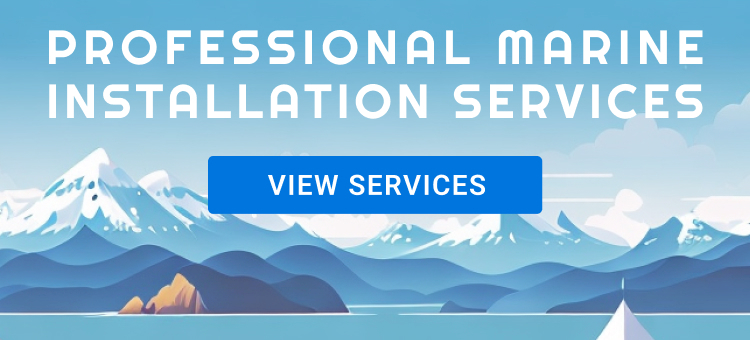






 $1,145.76
$1,145.76 $798.94
$798.94